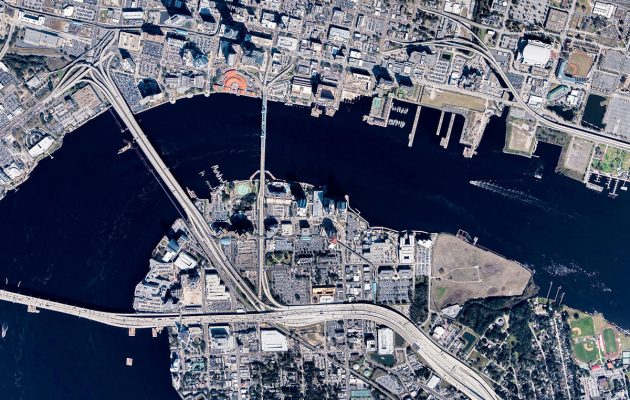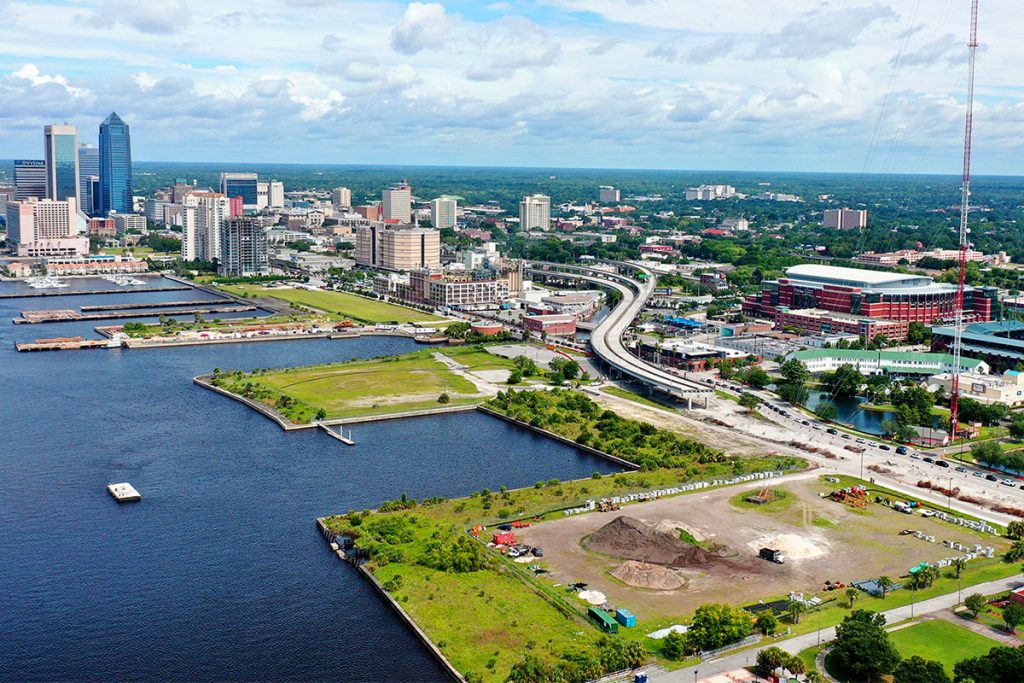Public access to river challenges best and highest use in future development
Posted on May 6, 2021 By Jennifer Edwards Brooklyn, Downtown, Springfield, Riverside, Avondale, Ortega, Murray Hill, San Jose, San Marco, St. Nicholas, Top Stories

Plans to transform the former Landing site on the St. Johns River and install public artwork are underway and soon to be revealed. And a new coalition of nonprofits and public interest agencies hope those plans are but the first step toward a string of parks along the North and Southbank of the river.
In March, City officials selected three firms out of 14 vying to design park on the former Landing property, which also contains two pads that are likely to be used for private development after the park is built. As part of the project, each firm is to include a significant work of public art, and will be paid $125,000 for its design, although only one plan will eventually be chosen and funded for the property, located at 2 Independent Drive W. The park must be at least four-and-a-half acres of the site’s more than seven-and-a-half, which includes a parking lot.
Currently Olin Partnership Ltd, based in Philadelphia; Agency Landscape + Planning LLC out of Cambridge, Massachusetts and Perkins & Will Inc. of Chicago are working on their designs, which will be crafted using a lot of public input, said Lori Boyer, City Downtown Investment Authority CEO.
“They are design firms who design park space,” she explained, noting that the three are not developers. “They are designing what goes in that park space, what it looks like. We have three different versions of that that we will be able to get to see at the end of June. We will then be selecting (the project).”
Olin Partnership Ltd is known for several high-profile projects including the Washington Monument Grounds in Washington, D.C.; New York City’s Bryant Park; the J. Paul Getty Center in Lost Angeles and Columbus Circle in Manhattan. Its architects also created a waterfront project in Alexandria, Va.
According to its website, “Olin creates distinguished landscapes and urban designs worldwide. Our work is predicated upon social engagement, craft, detail, materiality and timelessness. Our appreciation of the urban environment is paramount.”
Agency Landscape + Planning LLC is known for a long list of projects, including the Charleston Navy Yard Visitor Experience Plan; Chicago River’s Edge Ideas Lab; Chicago River Walk and the Sarasota Bayfront Master Plan. Part of its mission statement includes what its members term agency, which is described as “a mission-driven practice dedicated to addressing social equity, cultural vitality and environmental resilience through design excellence, strategic planning and community engagement.”
The third firm, Perkins & Will Inc. has studios all over the United States and throughout the world. Its projects include the National Museum of African American History in Washington, D.C., Waterfront Botanical Gardens in Louisville, Ky. and the Historic Emancipation Park in Houston.
“Our goal is to design places that make a positive difference in the world. That’s why people are at the heart of everything we do,” according to the Perkins & Will website.
The commitment to replace what once was an eyesore with a beautiful outdoor park for the public to enjoy is music to the ears of a new coalition of private individuals, nonprofits and public organizations that have teamed up to advocate for a park system along the river. But the members of Riverfront Parks Now want to see more than just the Landing site turned into public space for all to enjoy.

Riverfront Parks Now consists of representatives of multiple community organizations including the St. Johns Riverkeeper; the Sierra Club; Duval Audubon Society; Scenic Jacksonville; Jacksonville Urban League and many others. Its members “envision a connected network of extensive public green space and active parks along Jacksonville’s riverfront that maximizes public access, reconnects the community to our river and creates a sense of place,” according to its mission statement. The group began forming last year, after multiple factors converged: flooding from Irma; the expiration of the development rights to the Shipyards and the demolition of the Landing and the old Courthouse. A survey conducted by the Riverfront Parks Now showed that 50 percent of the riverfront is now City-owned.
Nancy Powell, project manager for the Riverfront Parks Now steering committee and executive director of Scenic Jacksonville, said Riverfront Parks Now represents 13 organizations and more than 5,000 people who want to see what’s left of the riverfront preserved.
“It is our mission to advocate for a major destination riverfront park and network of parks in downtown Jacksonville that we feel will help spur downtown revitalization, provide flood control and resiliency and attract economic investment, but most of all to be a showcase for the citizens of Jacksonville, a place to be outdoors and healthy, a place to be proud of, that so many others have figured out,” Powell said. “We only have 10 percent of our Riverfront that is left because the rest is already privatized, across the whole riverfront, across our county. Those places where it is publicly owned happen to be downtown Jacksonville – Metropolitan Park, the Shipyards, the Landing and some other properties that may be developed. The Shipyards and parts of Metropolitan park have been targeted for development, and once (the public land is) gone, it’s gone. We really need to be thoughtful about giving public access to our people to the waterfront. There are people on the Northside and other places who don’t get access to the river. A free public park system that is really well done can bring all of our community together. We feel it is a win, win, win.”
Powell said Riverfront Parks now is helping to give input for the design of the Landing space.
For Boyer, of DIA, the idea of more public greenspace and parks along the river is welcome. Where City official and Riverfront Parks Now members differ is in terms of scope.
“A park system along the river is something that we’ve always had planned,” Boyer said.
“That’s not new. We have always viewed both sides of the river and the Riverwalk as an interconnected park system. We value their emphasis on it. The fact that (Riverfront Parks Now is) bringing it to the fore and advocating for those really extraordinary park spaces downtown as a destination, we completely agree with. It’s great to have them focused and bringing that level of attention to the issue. The places where we depart are whether every piece of publicly owned property along the property needs to be a park or whether some of it as private development could support or enhance the park space. They are taking it a step further and are asking that all City property along the property be considered for park property. That’s a step further than we have been.”
By Jennifer Edwards
Resident Community News




 (No Ratings Yet)
(No Ratings Yet)Jacksonville Landing, Northbank, Riverfront Parks Now, Southbank, St. Johns river





